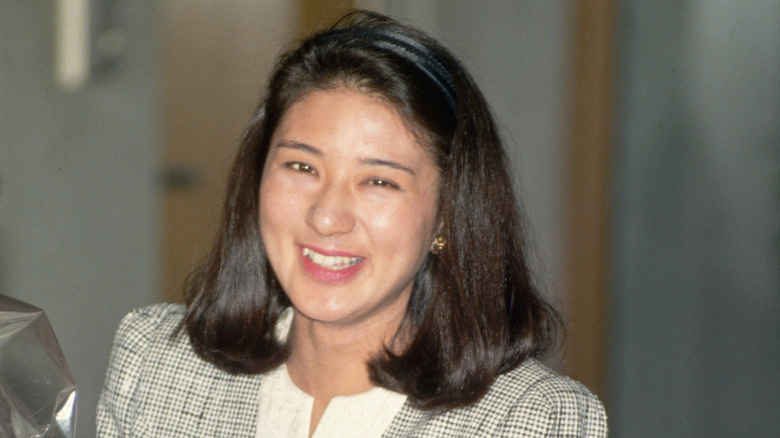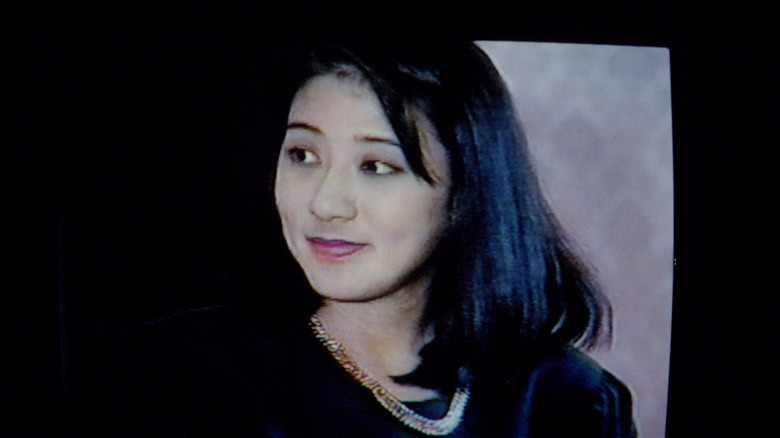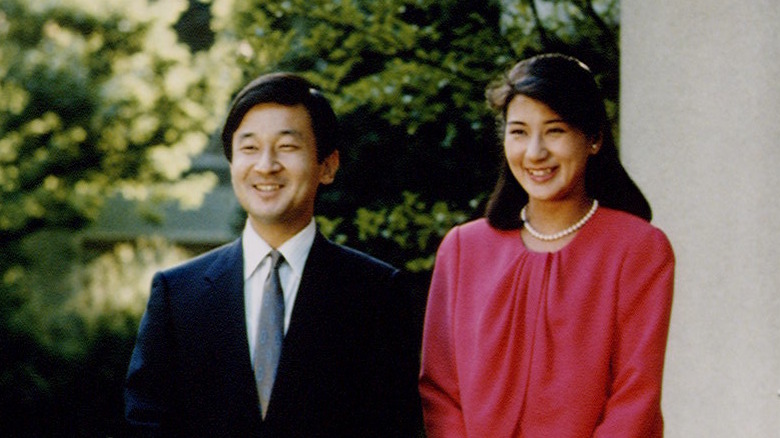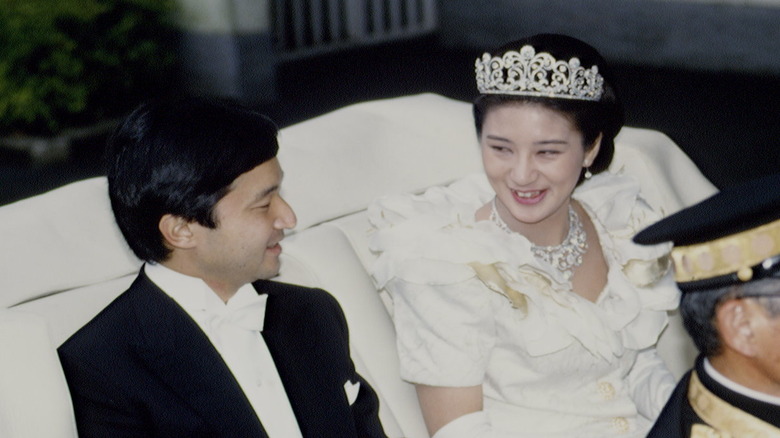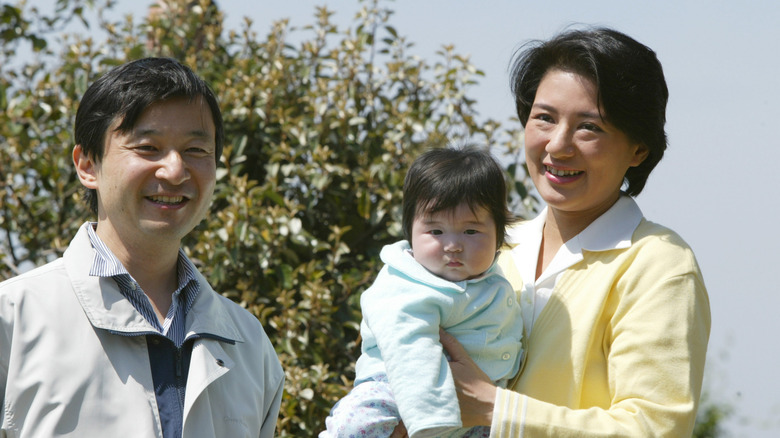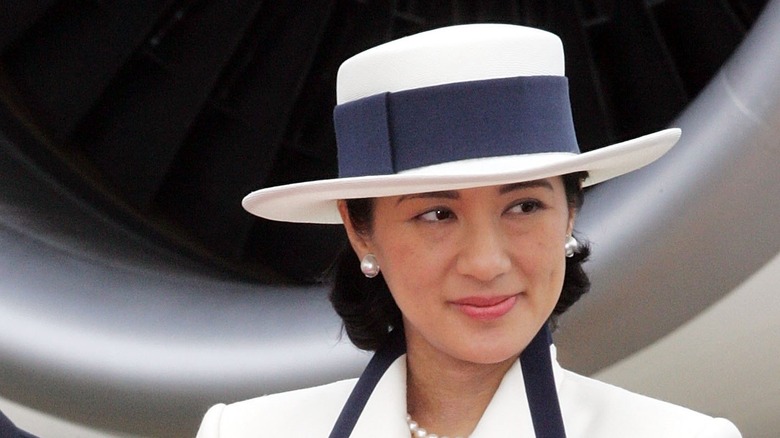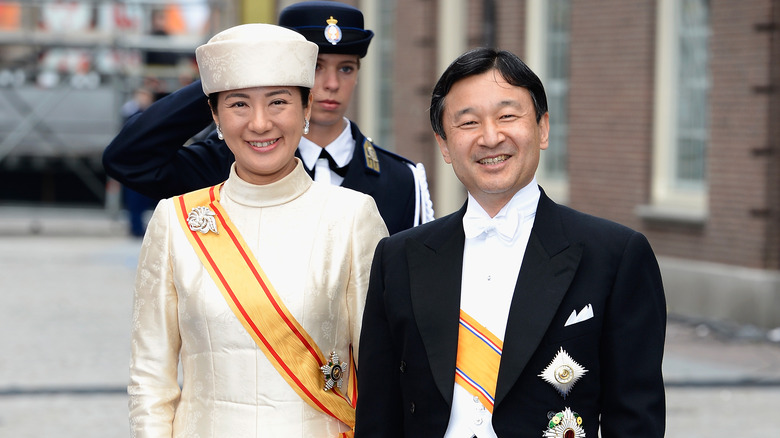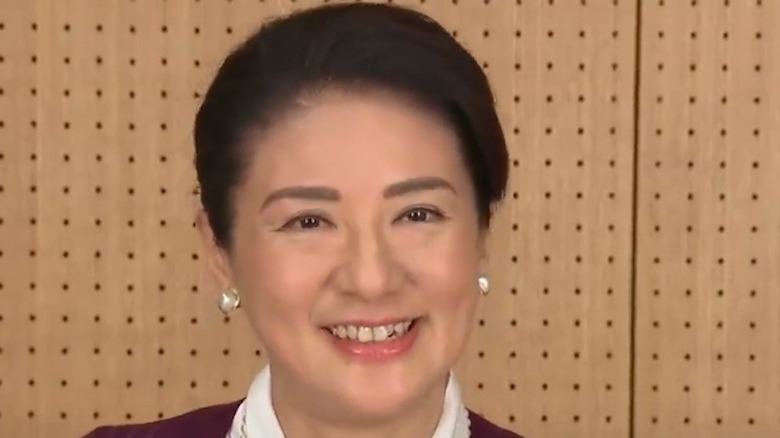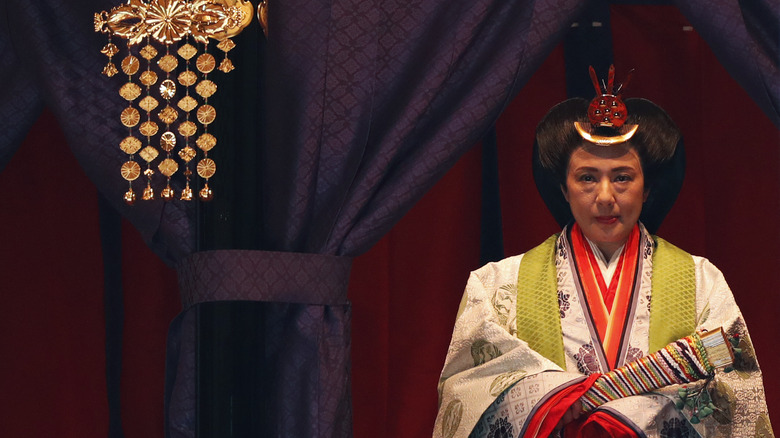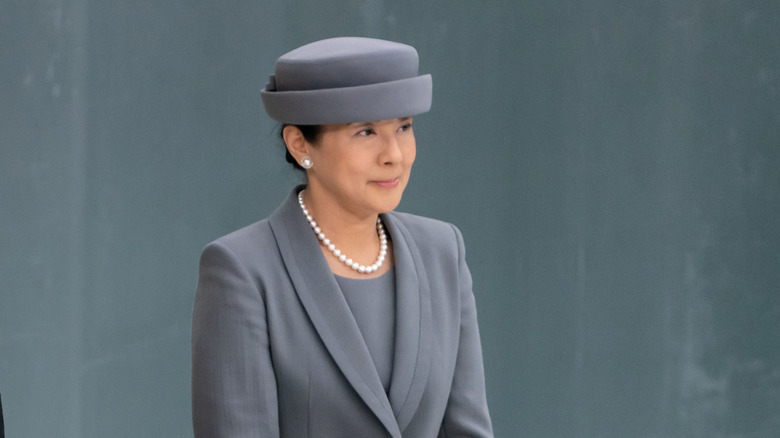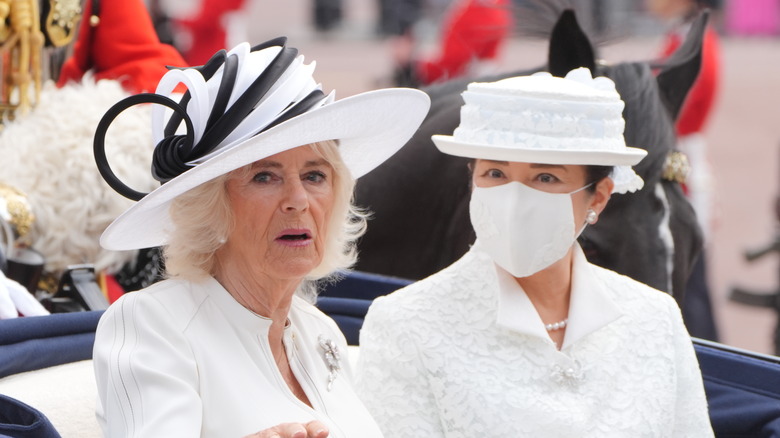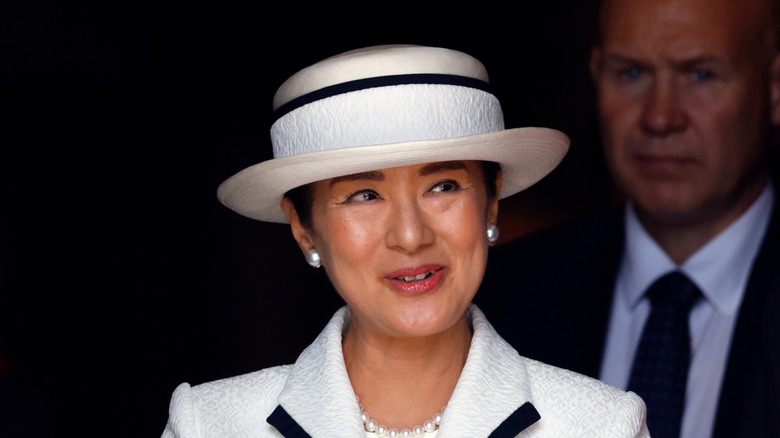The Stunning Transformation Of Japan's Empress Masako
While considering the monarchy, most people immediately think of Britain's royals and their seemingly endless stream of palace intrigue. Yet the House of Windsor are newcomers when compared to the ancient Imperial House of Japan. In fact, Japan's royal family is actually the oldest in the world, with the same family remaining in place for more than 2,600 years to constitute the longest continuous hereditary reign in the history of the world. In 1947, Japan's monarchy evolved from one of rulership to becoming entirely ceremonial; that said, the royal family — as is the case in Britain and other nations that have undergone similar shifts to their monarchies — remains powerfully symbolic for the people of Japan, representing the country's long history and time-honored traditions — even if they no longer rule the kingdom.
In 2019, Emperor Akihito, who's sat upon the Chrysanthemum Throne since his father's death in 1989, broke with centuries of tradition when he abdicated due to ill health. His son was then crowned, with Emperor Naruhito and his wife, Empress Masako, taking their places at the head of this legendary dynasty. This transition from heir apparent to emperor was not without its hiccups for the fledgling emperor, for various reasons. Chief among these was the elevation of his wife to empress, given her reputation as a reluctant royal whose reclusiveness has been well documented over the years.
To find out more about this fascinating public figure, read on to experience the stunning transformation of Japan's Empress Masako.
Empress Masko earned a Harvard degree before becoming a diplomat
Before she became Empress Masako, the future royal was born a commoner, named Owada Masako. Her father was hardly a peasant, though, holding a lofty position within Japan's Ministry of Foreign Affairs. His job within the world of international diplomacy meant the family moved all over the globe, and young Masako was able to experience other parts of the world when she was still a child. In fact, she lived on both sides of the Iron Curtain — in the U.S. and the Soviet Union — when her father was stationed in both countries as a diplomat at various times.
Masako followed in his footsteps. After earning an economics degree from Harvard, she continued her studies at the University of Tokyo. In 1987, she joined the Ministry of Foreign Affairs (she was reportedly one of just three women out of 800 female applicants to pass the entrance exam), which sent her to study further at Oxford. As BBC News noted, the multilingual future royal (she also speaks French, German, and English) helped to negotiate trade deals between Japan and the U.S.
Smart and talented, Masako was seen as a rising star in the ministry. Her promising career in international diplomacy, however, was destined to take a detour due to a chance meeting in 1986 while she attended a reception at the Tokyo Imperial Palace that would change her life in ways she couldn't have begun to imagine.
Her romance with Crown Prince Naruhito made headlines
While Owada Masako attended that royal reception, she captured the eye of Prince Naruhito, first in line to the Chrysanthemum Throne. As People reported, the crown prince was infatuated and they began to date. They had much in common; both had studied abroad, experiencing life outside the confines of Japan. Like Masako, the prince also attended Oxford, where he was able to shed the burdens of royalty and live in a dorm room like any other student. That period in his life, in fact, remained a defining experience for him. "This had been a happy time for me — perhaps I should say the happiest time of my life," he wrote in his book, "The Thames and I: A Memoir of Two Years at Oxford," reported Tokyo Weekender.
Naruhito popped the question. Reluctant to leave the job she loved, which she'd prepared for her entire life, she turned him down. He proposed again, and she once said no. After six years pursuing her, Naruhito eventually wore her down, and in January 1993 the couple announced their engagement.
He was only able to finally persuade her, she said, when he made her a solemn vow. "His Highness told me that 'you may have many worries and anxieties about entering the imperial house, but I will do everything in my power to protect you as long as I live,'" she said during a press conference, via Tokyo Weekender.
She was dubbed 'Japan's Princess Diana' after her royal wedding
Prince Naruhita and Princess Masako were married in a lavish ceremony held on June 9, 1993, declared a national holiday in Japan. Unlike Britain's royal weddings, the ceremony wasn't televised; all TV viewers saw was the couple walking to the shrine in which the nuptials were held. The newlyweds later changed out of their traditional garb — a sharp tux for the groom and a white gown for the bride, who also wore a diamond-encrusted tiara. They capped things off by being driven through Tokyo in a Rolls Royce, greeting the throngs of well-wishers who lined the streets.
Not only was the wedding a huge event in Japan, fans worldwide became entranced with the fairytale-style love story of the handsome prince who fell for a beautiful commoner. As the comparisons to the beloved royal who married then-Prince Charles a decade earlier rolled in, she was dubbed "Japan's Princess Diana."
It would eventually emerge that those comparisons were apt in more than just superficial ways. Like Diana, Masako also experienced difficulties adapting to her new role, and it wasn't long before those struggles came to play out in public.
The arrival of her first child sparked an imperial succession debate
After a royal heir gets married, it seems like the pressure to produce the heir's heir sets in straight away. Prince Naruhito and Princess Masako know this all too well. In the years since their wedding, media speculation about a royal baby had escalated to a fever pitch. In 1999, the Japanese public was thrilled by a newspaper report claiming that she was pregnant — and then devastated when it was later revealed that she'd suffered a miscarriage. "I want to say how much the pressure was put on the crown princess by a report from a particular newspaper saying there was proof [of the pregnancy] before the medical results were known," said Kiyoshi Furukawa, a representative of the crown prince's household, as reported by The Guardian.
Two years after that miscarriage, the couple welcomed their first child in December 2001, a daughter: Princess Aiko — whose formal title became Aiko, Princess Toshi. The couple would not have any other children.
This created something of a conundrum when it came to the imperial succession, given that Japan remained a primogeniture (meaning that the crown transfers to the next male heir). While there was discussion of Japan following suit with various European monarchies that had adopted the principle of primary primogeniture (in which the crown goes to the oldest child, regardless of gender), that didn't happen. Naruhito's brother, Fumihito, Crown Prince Akishino, is the heir presumptive to the throne.
A stress-induced psychological disorder forced the 'broken butterfly' to step back from public life
The stress of being in the public eye, and the unrelenting pressure to produce an heir, became too much for Princess Masako to bear. Eventually, all that strain came to manifest itself physically. When Princess Masako was hospitalized with a severe case of shingles in late 2003, Prince Naruhito pointed to the intense stress she experienced, and he pointed to unnamed palace officials as the culprits. "For the past 10 years, she has tried very hard to adapt herself to the imperial family," the prince declared during a news conference, as reported by The Guardian. "In my eyes, she appears totally exhausted from it."
As NBC News reported, the Imperial Household Agency confirmed that the princess was suffering from adjustment disorder, a psychological ailment brought about by stress, anxiety and depression. Masako was reportedly being treated for her condition with a combination of therapy and medication. The prince announced that she'd be stepping away from the public eye for the immediate future. As for when she might return, he couldn't say. "It may take longer for her to recover than we had originally thought," he observed.
And that was that. She retreated, and in the years that followed, appeared in public only sporadically. The Japanese press that had previously described her as "Japan's Princess Diana" soon came to refer to her by a new nickname: the "broken butterfly."
If you or someone you know needs help with mental health, please contact the Crisis Text Line by texting HOME to 741741, call the National Alliance on Mental Illness helpline at 1-800-950-NAMI (6264), or visit the National Institute of Mental Health website.
She made a rare public appearance in 2014
Princess Masako's public appearances over the next few years became fewer and further between, typically just a small handful each year. When they did occur, it usually involved attending the occasional official function, sometimes a funeral, or simply just waving from a balcony. Beyond those rare times she did step out, she lived a life of seclusion, well out of the public eye. In 2013, she and husband Prince Naruhito made a rare joint appearance when they attended the inauguration of King Willem-Alexander of the Netherlands. That marked her first overseas trip in more than a decade, and was viewed by many in the Japanese media as being a positive sign pointing to her potential recovery.
In 2014, she made headlines when she attended an official state banquet welcoming the Dutch king to Tokyo, a further indication that she was doing better. Gradually, she began stepping into the spotlight a bit more frequently. Still, these were baby steps; she was still a few years ago from making any public statements.
She admitted she feels 'insecure' in her role as a royal
In 2018, Princess Masako returned to the public eye once again. It's debatable whether the decision was hers or whether she was pushed into it; her re-emergence came on the heels of an official announcement from her father-in-law, Emperor Akihito, revealing he'd be stepping down from the throne the following year due to his faltering health — the first time in more than 200 years that a Japanese monarch abdicated.
Appearing in a video alongside her husband, she seemed relaxed and content. "I want to devote myself to the happiness of the people, so I will make an effort to that end while gaining more experience," she said in a written statement that was issued, as reported by People.
While she admitted she was "insecure" about assuming her new role as empress, she did indicate that she'd been experiencing improvements in both her mental and physical health. "I am delighted at the fact that I can perform more duties than before as I have tried to improve my physical condition," she added.
She became empress when her elderly father-in-law abdicated in 2019
On April 30, 2019, Emperor Akihito made history when he abdicated the Chrysanthemum Throne. His firstborn son became Japan's 126th monarch, Emperor Naruhito, while his wife became Empress Masako.
The newly installed empress followed her husband's lead as she prepared to reign by his side. "He will be a fantastic emperor," Keith George, a longtime friend of the emperor's, told the AP. "He is a caring person. He is a humble person. But he has never forgotten his duties as the crown prince, and he will never forget them as the emperor." According to George, Naruhito's royal ancestry belied his man-of-the-people spirit, and his focus on the greater good. "He doesn't look at everything in terms of what it means for him," George added. "He looks at it in terms of what it means for the people around him."
At that time, Masako's role in her husband's reign had yet to be fully fleshed out, due to the stress-related condition that had kept her mostly sidelined for well over a decade. Still, there was no denying that as high as her profile was as princess, it had escalated significantly once she'd become empress.
She celebrated her 60th birthday with a call for global peace
In 2023, Empress Masako marked a big milestone when she celebrated her 60th birthday. While she didn't engage in any public activities, she did issue a statement via Japan's Imperial Household Agency, as reported by EFE. "I have deep gratitude to everyone who has taken care of me, starting with my parents, who raised me with love," she declared.
In that statement, she looked back at some of the misfortunes that Japan had experienced in the years since she'd joined the royal family, including 1995's Great Hanshin earthquake and the devastating tsunami that slammed into Japan in 2011. In addition to natural disasters, she acknowledged loss caused by war, and expressed that she hoped to see humankind work toward a more peaceful and compassionate place.
At the same time, she also hinted that she was making progress in the personal problems that had plagued her for the past two decades as she arrived at her 60th year, known as kanreki in Japan. "I want to lead my future life by taking the first step with new feelings and making further efforts," she added, via The Asahi Shimbun.
The reason she wore a mask during a carriage ride with Britain's royals
In June 2024, Empress Masako returned to public duties in a big way when she accompanied Emperor Naruhito on a state visit to Great Britain. The couple have deep ties to the U.K., given that both attended Oxford — albeit at different times — during what was a very formative time for both spouses.
During that visit, they were welcomed by King Charles and his wife, Queen Camilla, with the red carpet rolled out for them — literally — at Buckingham Palace. As the AP pointed out, the visit was about far more than one country's royals hanging out with another country's royals. The actual intent was to strengthen ties between Britain and Japan, a crucial building block in the economic survival of the U.K. after the nation's messy split with the European Union after the Brexit referendum.
One curious moment in that visit came when Empress Masako was riding in a horse-drawn carriage with Queen Camilla, wearing a white face mask. Many observers found this odd, given that the empress was utterly mask-free during the other segments of the visit. There was, however, a very important reason why she wore the face covering emerged in a tweet issued by Daily Mail royal editor Rebecca English. "I am told the Empress is allergic to horses which is why she is wearing a mask," English revealed.
She joined Instagram in 2024
Empress Masako took a big step toward the spotlight she'd been avoiding since the 2000s when Japan's royal family joined Instagram in 2024. The Instagram feed appears to be modeled on that of Britain's royals, serving up a combo platter of personal (albeit carefully staged) family photos and coverage of the royals carrying out various public functions. The account, noted Harper's Bazaar, was shared by the empress and emperor, along with their daughter, Princess Aiko.
As with the Instagram posts of Britain's royal family, there's little spontaneity to be seen. One, for example, boasts highlights of the emperor and empress during their visit to London, which included meeting with King Charles III and Queen Camilla, and future monarch Prince William. Another post revealed that, during that visit, the couple also paid a visit to Oxford, where Empress Masako received an honorary degree from her alma mater.
"We are very grateful that after this luncheon, my wife, Masako, who also had the privilege of studying at Balliol College for two years — five years later than myself — will be honored with the conferment of an honorary degree of Doctor of Civil Law," Emperor Naruhito said in a speech commemorating his wife receiving that degree, via the University of Oxford. "Masako and I are always reminiscing about the happy and irreplaceable days we experienced in Oxford."
